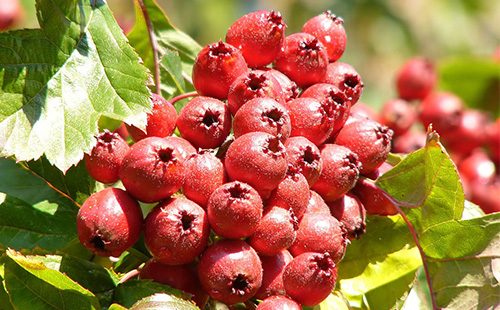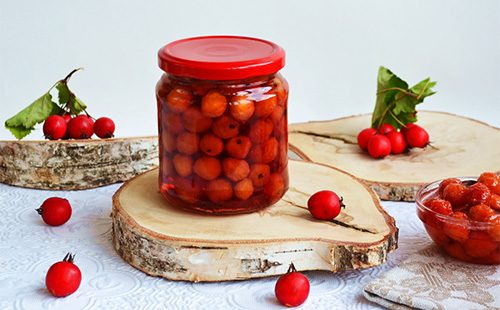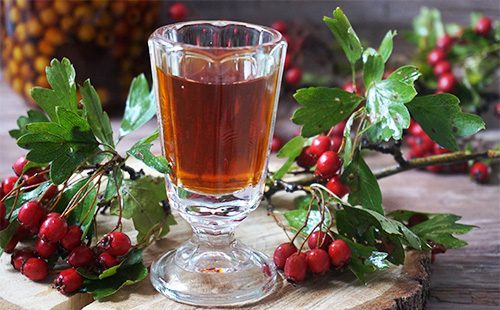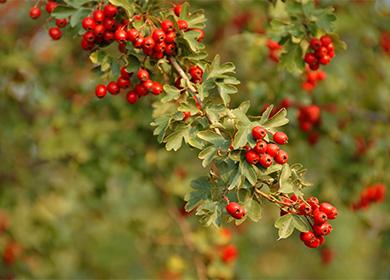The content of the article
Hawthorn is a diverse genus of shrubs or small trees that are widespread in the northern latitudes. It has 1250 species, most of it grows in North America. In Russia, there are only 39, which are popularly called glod, the mistress tree, the boyar.
The origins of the name are interpreted in different ways. Folk are associated with the appearance of the shrub: during the flowering period, it is transformed, looks like an elegant lady, hung with bright beads and earrings. The official is a translation of the Latin term Crataegus, identical to the ancient Greek word "strong." According to one version, this designation is associated with strong, powerful wood of trees, according to another - with the ability to survive in difficult conditions and maintain strength for hundreds of years.
Botanical characteristic
Traditional medicine ascribes medicinal properties to all types of hawthorn, but the content of useful substances has been scientifically confirmed only in some of them:
- single-pedal;
- five-pistil;
- blood red;
- prickly (ordinary).
Other plant species are not characterized from the point of view of pharmacological raw materials for one reason: the composition and properties are not well understood. This "omission" has been eliminated in recent years by Russian scientists who regularly submit works on the content of active components in flowers and fruits of shrubs growing in different regions of our country.
Description
Powerful shrubs up to 5 m high and small trees reaching 12 m in height belong to the Rosaceae family. They are found in wooded, mountainous, lowland areas. Extremely unpretentious to soils, grow even on dense clay soils, but demanding on the amount of moisture, do not tolerate stagnation of subsoil waters.
Widespread in temperate latitudes contributed to frost resistance of crops. They are sun-loving, therefore, despite the frequent proximity to trees of other species, they never grow under a continuous forest canopy. Choose open areas, clearings, mountain slopes, where they get free access to sunlight.
The bark of different shades of gray, sometimes brown, is covered with deep cracks, rough, often exfoliates from the trunk with large plates. The crown is formed by strong, shiny branches. Young shoots are olive-green, usually covered with a “felt gun”, but become absolutely smooth with age. But the needles gain strength and reach a length of 4 cm. The crown of the common hawthorn is ellipsoid, round in shape, asymmetrical in shrub species.
Leaves are ovoid or rounded. Blood red hawthorn is distinguished by plates with a pointed apex, and prickly, on the contrary, with a blunted one.The leaves are serrated at the edges, the surface is densely covered with hairs, from bright green in the outer part to a deep muted or bright in the inner. The monoecious species retains foliage until late autumn and often discards it green. Blood red - turns yellow already since the beginning of September and loses leaves first among the surrounding trees.
Flowering and fruiting
Like many trees in the northern latitudes, hawthorn leaves late. It happens that between the appearance of leaves and flowering, very little time passes, literally a couple of weeks. Because of this, it seems that the bush stands naked for a long time, but when it comes to life after hibernation, it transforms very quickly.
In warm regions it blooms in mid-May, in cool regions in the first half of June. The flowers are small, each with a diameter of up to 1.5 cm. But collected in inflorescences, they form spectacular “clusters”. They are located only at the ends of the young shoots of the current year. Saturated white or pink, in some species with a red dot in the middle.
Flowering is fast. In hot weather, the hawthorn blood red fades in just two days. Under favorable weather conditions, flowering lasts up to a week, but on average it takes three to five days.
The fruiting period is the beginning of autumn. At this time, in place of the "cluster of flowers" fruits are poured that look very similar to apples. They are small, in diameter up to 15 mm, round or oval in shape. Edible, with mealy flesh, usually red. An exception is the five-pistil species, the fruits of which are richly brown, almost black, with a bluish bloom.
Harvesting of raw materials
Flowers and fruits have medicinal value, therefore, the collection of raw materials is carried out in two stages.
- At the beginning of flowering. When collecting flowers, it is important not to lose precious time, so the workpiece begins when the inflorescences appear, without waiting for them to open. Cut off whole inflorescences and individual flowers. Harvesting is carried out only in dry weather, dew or rain on the eve may cause darkening of the raw materials. Dry immediately or no later than two hours after collection in well-ventilated areas. They sprinkle a thin layer on paper, newspapers, the room is closed at night to prevent moisture from getting inside. High hygroscopicity of flowers is their significant drawback, the preservation of moisture in them greatly reduces the healing properties of phyto-raw materials, and causes its premature damage. Properly prepared, it is stored in a glass container for two years.
- After fruit ripening. When collecting fruits should not be rushed. On the contrary, they wait when they are full. Therefore, the second stage of raw material harvesting often occurs during the period of early frosts - the end of September, the first decade of October. Collect fruits in bags, baskets, tearing them in clusters or individual berries. For drying, use rooms with good ventilation, where the fruits are scattered with a thin layer on paper at the rate of up to 5 kg per 1 m2. Carry out the workpiece and in drying chambers at a temperature of 50aboutC, keeping the raw material to dryness within 20-30% of the primary volume. Outside the dryer, evaporation of moisture occurs within eight days. After this, the mass is sorted out, weed impurities are separated, placed in boxes of plywood, dense breathable bags. Shelf life of raw materials is up to eight years.
Properties and Application
The first mention of the benefits of hawthorn dates back to the ancient Greek period. True, they used the drug at that time to treat diarrhea and digestive problems. His ability to influence the work of the heart and blood vessels was revealed at the end of the XIX century. The positive effect in heart disease was noted by the English physician Jening in 1896. And a little later, the famous American "home doctor" Walter Clement Alvarez called him a valuable discovery of the XIX century.
Composition
The content of biologically active substances in flowers and fruits is different. The former are rich in flavonoids, the concentration of which is higher in the buds, contain coffee and chlorogenic acids, amines, macro- and microelements, carotenoids and tannins.
The composition of dried fruits is extremely diverse and not fully understood. Scientists distinguish six main groups of substances in it.
- Bioactive complex. Includes flavonoids, a symbiosis of organic acids, tripertin and flavonoids glycosides. The complex has biological activity against the heart muscle, provides a cardiotonic effect.
- Phenolic substances. They include anthocyanins with high antioxidant activity, as well as catechins, flavanols. A positive effect of these substances on the work of the heart, their ability to relax the heart muscle with simultaneous correction of the rhythm, has been established. Phenolic compounds accumulate in the pulp gradually, as they mature. The later the collection of raw materials is carried out, the more pronounced the therapeutic effect will be.
- Pectins. The content of gelling substances in raw materials reaches 6%. This is due to the good astringency of the fruit, noted by medicine in antiquity.
- Sahara. The fruit pulp contains natural sugar sorbitol. It is a sweetener that does not increase the level of glucose in the body. Modern industry produces synthetic sorbitol, on the feasibility of inclusion in the diet of which disputes do not cease. The carcinogenicity of synthetic sugar has been repeatedly noted, while the natural one contained in the fruits of hawthorn is completely harmless and can be safely used in the diet of people with diabetes.
- Vitamins. Fresh fruits are exceptionally rich in ascorbic acid, the content of which is determined by the type of plant and is 18-100 mg per 100 g of raw material. As drying, the concentration of vitamin C decreases. Vitamins K, E and beta-carotene were also found in fruits.
- Minerals. The mineral composition of raw materials is extremely diverse. It revealed a high content of potassium and calcium; magnesium and iron are present in a significant concentration. Copper, zinc, aluminum complement the medicinal, nutritional value of herbal remedies.

pharmachologic effect
Herbal preparations from flowers and fruits have the following effects:
- selective expansion of blood vessels (coronary, brain);
- decreased excitability of the nervous system;
- increased intensity of oxygen supply to the heart;
- heart rate normalization;
- sleep improvement;
- improving well-being with heart disease;
- activation of metabolism;
- lower cholesterol.
It was established that medicines from hawthorn accelerate recovery after severe diseases of the cardiovascular system, eliminate the severity and other unpleasant sensations in the area of the heart muscle. Scientifically proven pronounced and prolonged sedation even after discontinuation of the drug.
In this case, the action of the plant differs from a number of other cardiotonic agents. By stimulating the work of the heart, it simultaneously reduces the frequency of contractions and the excitability of the heart muscle, which allows us to talk about its activity as a rhythm controller.Triterpenic acids, which are part of the fruit, stimulate the blood supply to the heart and brain, reduce blood pressure.
Therapeutic practice
The inclusion of hawthorn preparations in the treatment of patients with angina pectoris in the 19th century was a breakthrough in medicine. Until that time, it was not possible to stabilize and improve the condition of patients whose disease was accompanied by an increase in blood pressure, insomnia. At the same time, the ability of medicines based on a medicinal plant to improve blood circulation was noted, which made it possible to recommend herbal remedies for elderly people for the correction and prevention of cardiovascular diseases, as well as for women during menopause.
Currently, the list of indications for taking a medicinal plant in various forms includes the following diseases:
- circulatory failure;
- menopause;
- hypertension in the initial stage;
- atherosclerosis;
- angioneurosis;
- atrial fibrillation;
- angina pectoris;
- paroxysmal tachycardia;
- bradycardia;
- increased thyroid function.
The medication is justified in case of overexcitation, insomnia, dizziness. At the same time, drugs normalize the work of the gastrointestinal tract, stimulate metabolism.
Prescription Drugs
Hawthorn preparations are presented in four finished dosage forms:
- Alcohol tincture from fruits. Assign for rheumatic disorders.
- Alcohol tincture of flowers. Recommended for hypertension, dizziness, heart palpitations.
- Liquid extract. Dark brown liquid with a sweet taste. Assign with excitability of the heart muscle. The tool has a vasodilating effect, reduces the heart rate.
- Lozenges. Contain dry flower extract. They work similarly to a liquid extract, but are more convenient to use.
You can prepare a drug from hawthorn at home, using the following recipes.
Infusion of flowers
Features Recommended for hypertension, dizziness, sleep disturbances.
Preparation and use
- Pour dried flowers weighing 50 g into the bowl.
- Pour boiling water with a volume of 600 ml.
- Leave to infuse for 30 minutes.
- Strain.
- Take 200 ml three times a day.

Fruit infusion
Features It is indicated for hypertension and insomnia, disorders of the digestive tract (as an astringent), general weakness due to the pathology of the cardiovascular system and lack of nutrients in the diet.
Preparation and use
- Grind fruits weighing 100 g.
- Pour in a thermos, fill with 1 liter of boiling water.
- Cork tightly, leave for four hours.
- Strain.
- Take 100 ml before meals up to four times a day.
Infusion of alcohol
Features Means of long-term storage can be prepared with alcohol or vodka. The classic recipe for the herbalist M. Nosal involves the use of juice squeezed from flowers, mixed in a ratio of 1: 2 with 90% alcohol. But at home, it’s easier to prepare a tincture of dried fruits.
Preparation and use
- Grind 100 g of fruit.
- Pour alcohol with a strength of 70% in a volume of 1 liter.
- Cork, leave to brew for 14 days.
- Strain.
- Take 50 drops three times daily before meals, mixing with water.
Tea
Features The easiest way to apply hawthorn. Enrich the mixture of fruits and flowers with wild strawberries, rose hips, black currants. Helps with hypertension, insomnia, neurotic conditions, excessive activity of the thyroid gland.
Preparation and use
- Take the ingredients in equal proportions.
- Grind, mix.
- Pour into a mug, pour boiling water.
- Leave it for ten minutes.
- Use 200 ml three times a day.
Contraindications
Contraindications plants:
- hypotension;
- severe cardiac disorders;
- severe kidney disease.
If you like to enjoy the fresh fruits of hawthorn, be careful. More than 200 g of berries is not recommended to be eaten in one go - this can cause a sharp decrease in pressure and heart rhythm disturbance. But jam is not so "active", in such quantity it will bring the body only benefits and support the heart.

Reviews
One spring I felt very weak. At first I thought it was vitamin deficiency, but then pains began in my heart. After the examination, the local therapist prescribed a bunch of pills and potions, but only they did not help much. That's when I decided to be treated independently. I went to the pharmacy and bought "Cardio - asset" hawthorn. And I learned about it from my friend, who has been taking this drug for several years. The packaging price is low - 126 rubles. And on the same day she began treatment.
I took the tablets strictly according to the instructions, i.e. 2 times a day. To my surprise, the very next day the pain in the heart became less intense. And after three days they stopped completely. But I, as expected, drank the full course and for the past 3 months I don’t remember which side the heart “is” on.
ZASHARUSHEK, http://irecommend.ru/content/sredstvo-1-ot-serdechnykh-bolei-podrobnye-foto
I was very worried about problems at my former job. My heart started to hurt at night, showered at 3 in the morning from heart pain. So far I decided not to go to the doctor, I myself knew that it was definitely from the nerves. In addition, recently, doctors began to prescribe very expensive drugs from self-interest.
I decided to take the risk of self-medication and myself bought these pills with hawthorn. The first time I drank 2 tablets a day, after I drank 20 tablets. The night pains stopped. Now I’m finishing the pack I bought, but already 1 tablet a day. Maybe a little off topic, but I will add that I combined this dietary supplement with taking drops of motherwort infusion.
Tati, http://irecommend.ru/content/chot-i-ne-lekarstvo-no-pomogaet-pri-kardinevroze
The husband has high blood pressure and tachycardia, so drinking tincture is simply necessary to reduce pressure and to treat this heart disease.
Indications and pharmacological properties: it has a cardiotonic effect, reduces the excitability of the central nervous system, improves coronary and cerebral circulation, has an antispasmodic effect. Combined with B-blockers. (those who reduce the pressure, they know what I mean).
Course of treatment: 30 drops, 4 times a day. Drink for 1 month. Before meals! Of the side effects, in some cases, an allergic reaction.
The price is ridiculous! 10 rubles!!!Chika25, http://otzovik.com/review_639262.html

